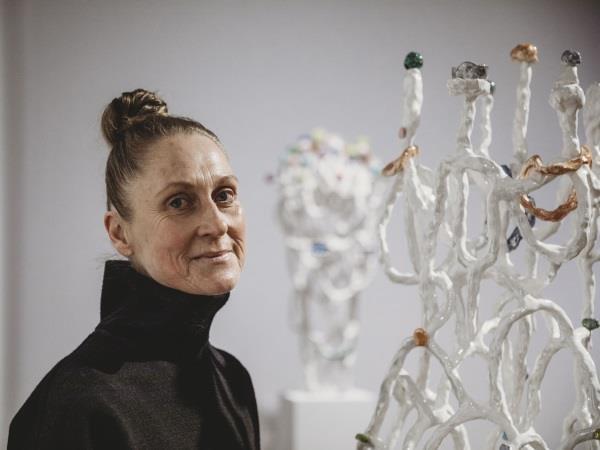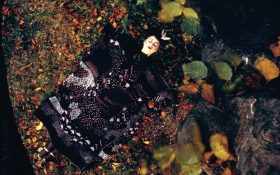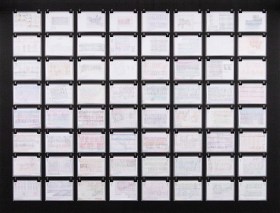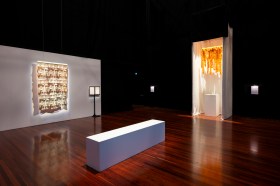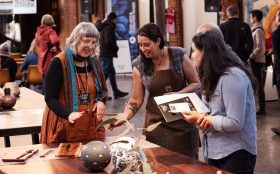Lynda Draper, recipient of the $50,000 Sidney Myer Fund Australian Ceramic Prize for 2019, with her winning work Somnambulism (2019). Photo: Amina Barolli.
Tucked away in the intermit space of a small Victorian Regional gallery is the jewel in the crown of art awards: the $50,000 Sidney Myer Fund Acquisitive Award, one of Australia’s most prestigious visual art prizes, promotes contemporary Australian artists working in the medium of ceramics. Squeezed between council offices and the performing arts centre in the town’s arts precinct, the Shepparton Museum of Art (SAM) has become the leading collector of ceramics in regional Australia, acquiring 175 works over its 28 year association with the Sidney Myer Fund.
Promoted as an opportunity for artists to push the boundaries of ceramics beyond its once functional associations, the six finalists, chosen from an initial group of 50 applicants from around Australia, were given time to develop their art with some financial support. Despite the intimacy of the upstairs gallery spaces where the exhibition is held, the curator Lara Merrington has convincingly unified a diverse group of artists through interlinking themes of ‘connections to place, experienced or imagined, and environmental concerns’ along with universal narratives and the notion of wonder. Merrington artfully manages the overtly functional nature of the galleries and the visitor experience through a considered contrast of styles, mediums and theme in which each artist is given their own space.
Lynda Draper, the winner of this year’s award for her body of work made from glazed ceramics titled Somnambulism (2019) – or sleepwalking – was chosen from an impressive group of finalists including Julie Bartholomew, Stephen Bird, Greg Daly, Juz Kitson and Isadora Vaughan. Inspired by a recent residency at the Château du Versailles on the outskirts of Paris as well as her own European heritage, Draper explores the theme of the ‘dream-space’ that sits between conscious and unconscious thought.
Responding to the neoclassical statues she discovered in the palace grounds, the artist has created her own busts of kings and queens in which she emulates the excesses of the Versailles environment; large, hand coiled, lace-like loops piled one on top of the other, take on the appearance of lofty crowns of royalty. They sit, poised on their white plinths, while glazed shapes that stud the works like jewels give a sense of the precious. The works exude both a naivety and sophistication through their rough coiling and deft ability to defy the density of the medium from which they are made. As a body of work however they require time to be experienced and, despite being award-winning, demand greater space than is possible in their present environment. To be fully realised the artist’s works might have to wait for the completion of the new SAM, an ambitious new gallery project ear-marked for completion at the end of 2020.
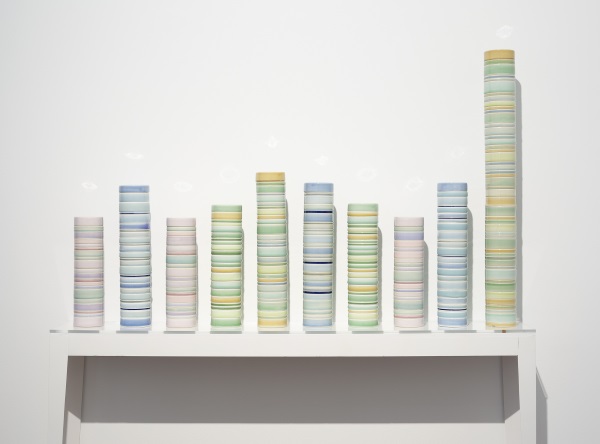
Installation view of Julie Bartholomew’s Anthropogenic Scrolls (2019). Photo: Christian Capurro.
In contrast to Draper’s imaginative interpretation of landscape and place, Julie Bartholomew’s Anthropogenic Scrolls (2019) and Greg Daly’s Line of Sight: Captured Moments (2019), draw more literally from the environmental experience and issues. Both artists are masters of form and finish. Bartholomew’s work made from thrown porcelain, glazes, glass and digital print on paper explores the change in our environment through Antarctic ice core extraction. Expressed through porcelain columns with discs of varying colour glazes to indicate the ice core at changing depths and interspersed hand caste glass to suggest carbon capture, the body of work reflects the fragility of our environmental situation. Daly on the other hand explores the wonders of an ever changing landscape observed from his studio window. Using lustre glazes on varying porcelain forms mounted on rebar steel legs along with video support, Daly immerses the viewer in his awe for the natural world. The power of both these bodies of work is possibly experienced most fully through their finished surfaces.
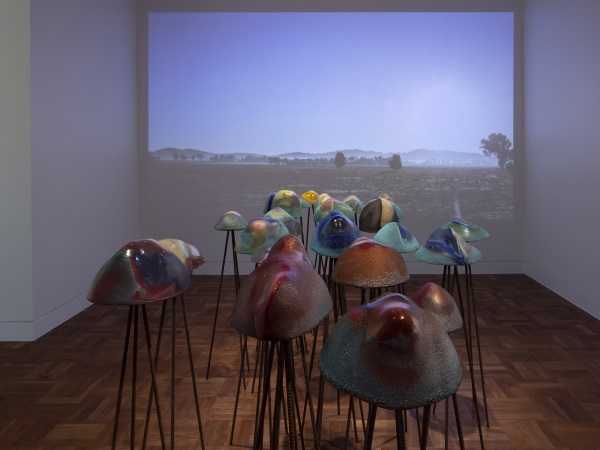
Installation view of Greg Daly’s Line of Sight: Captured Moments (2019). Photo: Christian Capurro.
Isadora Vaughan’s roughly formed bricks to create sculptural wall pieces are mounted on steel supports and reflect her ongoing fascination with ‘a material’s ability to transform or transition from one state to another.’ Responding to both the medium of ceramics and its regional context, Vaughan alters and plays with the clay surfaces. In Brickworks (Touch) (2019), a work in ceramic brick and steel epoxy, she uses her body weight, fingers, knees and elbows to form traces on the clay surface. Vaughan’s work playfully explores the intersection between utility and creative exploration.
Despite the differences between Vaughan’s raw and powerful sculptural pieces and Juz Kitson’s more refined works, Kitson also deals with the notion of contrast. In Temporal Fluidity (2019) the artist gathers materials and influences from a myriad of sources, using Jingdezhen and Dehua porcelain with hand-blown glass, reclaimed textiles and pelts of animal road-kill. In many ways this body of work defies description and challenges our notions of beauty and the grotesque. Stephen Bird’s Continent of exiles (2019), also uses imagery from a range of sources such as news tabloids and song lyrics to folk tales and myth. His painterly clay wall plates and figurative forms explore a range of narratives with humour and wit.
Merrington’s decision to confine text labels and interpretive material to one place in each gallery is a smart one as it affords the viewer an uninterrupted visual experience in a small space. Stairs and lifts provide access to the galleries and disabled toilets are also accessible. For people with disabilities, however, some of these spaces may be difficult to navigate.
Challenging and interrogating the medium of clay in diverse and unexpected ways, the six finalists in this award show reflect the ongoing possibilities and challenges of a medium no longer confined to the purely utilitarian.
An exhibition worth making the time to visit and experience the artists’ jewels in the crown.
3.5 stars out of 5 ★★★☆
Sidney Myer Fund Australian Ceramic Award 2019
Finalists: Julie Bartholomew, Stephen Bird, Greg Daly, Lynda Draper, Juz Kitson and Isadora Vaughan
22 June-1 September 2019
Shepparton Art Museum, 70 Welsford Street, Shepparton VIC
Free admission
